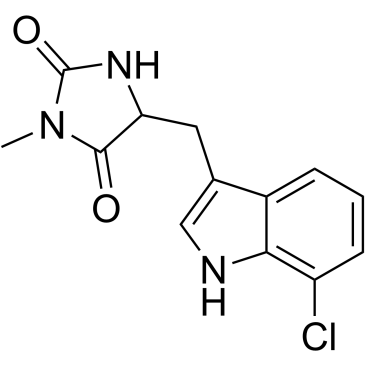Necrostatin-2, formerly known as (±)-Necrostatin-2, 7-Cl-O-Nec-1 and Nec-1s, is a racemic mixture of Necrostatin-2 that inhibits receptor-interacting protein kinase 1 (RIPK1) autophosphorylation. Necrostatin 2 (also known as Necrostatin-2, Necrostatin-2 racemate, (±)-Necrostatin-2, 7-Cl-O-Nec-1 and Nec-1s) is a potent necroptosis inhibitor with EC50 of 50 nM. It is a racemic mixture that prevents the autophosphorylation of the receptor-interacting protein kinase 1 (RIPK1). A controlled caspase-independent cell death mechanism called necroptosis produces morphological characteristics that resemble necrosis. It can be brought on by TNF-alpha-treated human Jurkat T cells with a FADD-deficient variant. An animal ischemic stroke model showed that necrostatin 2 was also effective. The pharmacokinetics of necrostatin 2 were moderate, and it quickly entered the central nervous system after being administered intravenously.
Physicochemical Properties
| Molecular Formula | C13H12CLN3O2 |
| Molecular Weight | 277.70628 |
| Exact Mass | 277.061 |
| Elemental Analysis | C, 56.23; H, 4.36; Cl, 12.77; N, 15.13; O, 11.52 |
| CAS # | 852391-15-2 |
| Related CAS # | Necrostatin 2;852391-19-6;Necrostatin 2 S enantiomer;852391-20-9 |
| PubChem CID | 643953 |
| Appearance | White to light yellow solid powder |
| Density | 1.5±0.1 g/cm3 |
| Index of Refraction | 1.676 |
| LogP | 1.76 |
| Hydrogen Bond Donor Count | 2 |
| Hydrogen Bond Acceptor Count | 2 |
| Rotatable Bond Count | 2 |
| Heavy Atom Count | 19 |
| Complexity | 403 |
| Defined Atom Stereocenter Count | 0 |
| SMILES | O=C1N(C)C(=O)C(CC2C3C(=C(C=CC=3)Cl)NC=2)N1 |
| InChi Key | WIKGAEMMNQTUGL-UHFFFAOYSA-N |
| InChi Code | InChI=1S/C13H12ClN3O2/c1-17-12(18)10(16-13(17)19)5-7-6-15-11-8(7)3-2-4-9(11)14/h2-4,6,10,15H,5H2,1H3,(H,16,19) |
| Chemical Name | 5-[(7-chloro-1H-indol-3-yl)methyl]-3-methylimidazolidine-2,4-dione |
| Synonyms | 7-Cl-O-Nec-1; Nec-1s; (±)-Necrostatin-2; Necrostatin-2 |
| HS Tariff Code | 2934.99.9001 |
| Storage |
Powder-20°C 3 years 4°C 2 years In solvent -80°C 6 months -20°C 1 month |
| Shipping Condition | Room temperature (This product is stable at ambient temperature for a few days during ordinary shipping and time spent in Customs) |
Biological Activity
| Targets | RIPK1 | ||
| ln Vitro | Nec-1s is a potent RIPK1 inhibitor and cellular necroptosis while lacking IDO inhibitory activity[1]. | ||
| ln Vivo |
Nec-1s is effective at minimizing brain injuries. It is a superior inhibitor that can be used in vivo and does not have a paradoxical sensitizing effect in TNF-induced lethality[1]. Nec-1s differs from Nec-1 in that it has a number of favorable pharmacokinetic and pharmacodynamic properties. Because of their lower in vivo and in vitro toxicity, Nec-1s have a safer safety profile than Nec-1[2]. |
||
| Enzyme Assay | Necrostatin 2 (also known as Necrostatin-2, Necrostatin-2 racemate, (±)-Necrostatin-2, 7-Cl-O-Nec-1 and Nec-1s, is a potent necroptosis inhibitor with EC50 of 50 nM. | ||
| Cell Assay | Cells were treated with indicated concentrations of drug. | ||
| Animal Protocol |
|
||
| References |
[1]. Cell Death Dis . 2012 Nov 29;3(11):e437. [2]. Molecules . 2018 Aug 3;23(8):1946. [3]. ell Rep . 2022 Oct 4;41(1):111434. |
Solubility Data
| Solubility (In Vitro) | DMSO: ≥ 50 mg/mL (~180.0 mM) |
| Solubility (In Vivo) |
Solubility in Formulation 1: ≥ 3 mg/mL (10.80 mM) (saturation unknown) in 10% DMSO + 40% PEG300 + 5% Tween80 + 45% Saline (add these co-solvents sequentially from left to right, and one by one), clear solution. For example, if 1 mL of working solution is to be prepared, you can add 100 μL of 30.0 mg/mL clear DMSO stock solution to 400 μL PEG300 and mix evenly; then add 50 μL Tween-80 to the above solution and mix evenly; then add 450 μL normal saline to adjust the volume to 1 mL. Preparation of saline: Dissolve 0.9 g of sodium chloride in 100 mL ddH₂ O to obtain a clear solution. Solubility in Formulation 2: ≥ 3 mg/mL (10.80 mM) (saturation unknown) in 10% DMSO + 90% (20% SBE-β-CD in Saline) (add these co-solvents sequentially from left to right, and one by one), clear solution. For example, if 1 mL of working solution is to be prepared, you can add 100 μL of 30.0 mg/mL clear DMSO stock solution to 900 μL of 20% SBE-β-CD physiological saline solution and mix evenly. Preparation of 20% SBE-β-CD in Saline (4°C,1 week): Dissolve 2 g SBE-β-CD in 10 mL saline to obtain a clear solution. Solubility in Formulation 3: ≥ 3 mg/mL (10.80 mM) (saturation unknown) in 10% DMSO + 90% Corn Oil (add these co-solvents sequentially from left to right, and one by one), clear solution. For example, if 1 mL of working solution is to be prepared, you can add 100 μL of 30.0 mg/mL clear DMSO stock solution to 900 μL of corn oil and mix evenly. (Please use freshly prepared in vivo formulations for optimal results.) |
| Preparing Stock Solutions | 1 mg | 5 mg | 10 mg | |
| 1 mM | 3.6009 mL | 18.0044 mL | 36.0088 mL | |
| 5 mM | 0.7202 mL | 3.6009 mL | 7.2018 mL | |
| 10 mM | 0.3601 mL | 1.8004 mL | 3.6009 mL |
